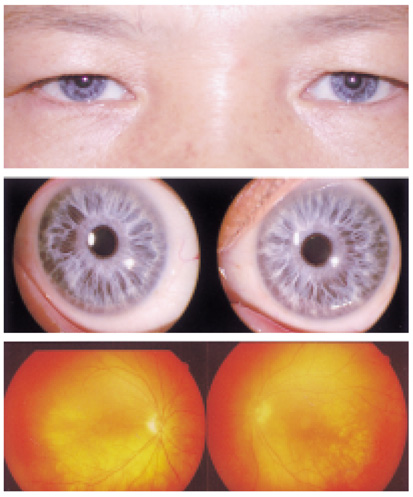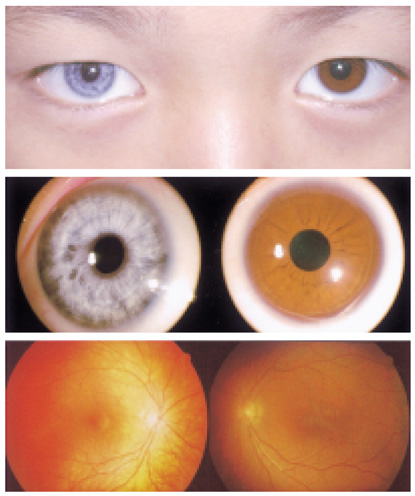Korean J Ophthalmol.
2004 Dec;18(2):185-189. 10.3341/kjo.2004.18.2.185.
Three Cases of Waardenburg Syndrome Type 2 in a Korean Family
- Affiliations
-
- 1Department of Ophthalmology, Ajou University, School of Medicine, Suwon, Korea.
- 2Department of Otolaryngology, Ajou University, School of Medicine, Suwon, Korea.
- KMID: 754386
- DOI: http://doi.org/10.3341/kjo.2004.18.2.185
Abstract
- Waardenburg syndrome (WS) is a rare, autosomal dominant disorder characterized by sensorineural hearing loss, pigmentary disturbances of the skin, hair, and iris, and other developmental defects such as lateral displacement of both medial canthi and lacrimal puncta called dystopia canthorum. While mutations of the PAX3 (paired box) gene have been identified in about 99% of WS type 1 cases, WS type 2 is a heterogeneous group, with about 15% of cases caused by mutations in microphthalmia associated transcription factor (MITF). We have experienced three cases of typical WS type 2 in a Korean family, for whom full ocular examination and genetic studies were performed. The genetic studies revealed no mutation in either PAX3 or MITF genes. The genetic basis, as yet unknown for most cases of WS type 2, might be found with further investigation.
Keyword
MeSH Terms
Figure
Cited by 2 articles
-
A Case of Waardenburg Syndrome Type 2 With Anisocoria
Seung Chan Lee
J Korean Ophthalmol Soc. 2010;51(10):1423-1426. doi: 10.3341/jkos.2010.51.10.1423.Identification of a Novel
De Novo Variant in thePAX3 Gene in Waardenburg Syndrome by Diagnostic Exome Sequencing: The First Molecular Diagnosis in Korea
Mi-Ae Jang, Taeheon Lee, Junnam Lee, Eun-Hae Cho, Chang-Seok Ki
Ann Lab Med. 2015;35(3):362-365. doi: 10.3343/alm.2015.35.3.362.
Reference
-
1. Waardenburg PJ. A new syndrome combining developmental anomalies of the eyelids, eyebrows and nose root with pigmentary defects of the iris and headhair and with congenital deafness. Am J Hum Genet. 1951. 3:195–201.2. Morell R, Spritz RA, Ho L, Pierpont J, Guo W, Friedman TB, Asher JH Jr. Apparent digenic inheritance of Waardenburg syndrome type 2 (WS2) and autosomal recessive ocular albinism (AROA). Hum Mol Genet. 1997. 6:659–664.3. Reed WB, Stone VM, Boder E, Ziprkowski L. Pigmentary disorders in association with congenital deafness. Arch Dermatol. 1967. 95:176–186.4. Ortonne J-P, Mosher DB, Fitzpatrick TB. Lotti T, Hercogova J, editors. Waardenburg syndrome. Vitiligo and Other Hypomelanoses of Hair and Skin. 1983. New York: Plenum Medical Book;337–368.5. Arias S, Mota M. Apparent non-penetrance for dystopia in Waardenburg syndrome type 1 with some hints on the diagnosis of dystopia canthorum. J Genet Hum. 1978. 26:101–131.6. Kim DK, Kim JH. A case of Waardenburg syndrome. J Korean Ophthalmol Soc. 1981. 22:687–691.7. Moon YS, Kim JC. Two cases of Waardenburg syndrome. J Korean Ophthalmol Soc. 1986. 27:735–740.8. Song HK, Shin DE. Three cases of Waardenburg syndrome in one family. J Korean Ophthalmol Soc. 1987. 28:1137–1142.9. Morell R, Carey ML, Lalwani AK, Friedman TB, Asher JH Jr. Three mutations in the paired homeodomain of PAX3 that cause Waardenburg syndrome type 1. Hum Hered. 1997. 47:38–41.10. Lautenschlager NT, Milunsky A, DeStefano A, Farrer L, Baldwin CT. A novel mutation in the MITF gene causes Waardenburg syndrome type 2. Genet Anal. 1996. 13:43–44.11. Tachibana M, Takeda K, Nobukuni Y, Urabe K, Long JE, Meyers KA, Aaronson SA, Miki T. Ectopic expression of MITF, a gene for Waardenburg syndrome type 2, converts fibroblasts to cells with melanocyte characteristics. Nat Genet. 1996. 14:50–54.12. Hageman MJ, Delleman JW. Heterogeneity in Waardenburg Syndrome. Am J Hum Genet. 1977. 29:468–485.13. Liu XZ, Newton VE, Read AP. Waardenburg syndrome type II. Phenotypic findings and diagnostic criteria. Am J Med Genet. 1995. 55:95–100.14. Coyle B, Coffey R, Armour JA, Gausden E, Hochberg Z, Grossman A, Britton K, Pembrey M, Reardon W, Trembath R. Pendred syndrome (goitre and sensorineural hearing loss) maps to chromosome 7 in the region containing the nonsyndromic deafness gene DFNB4. Nat Genet. 1996. 12:421–423.15. Pandya A, Xia XJ, Landa BL, Arnos KS, Israel J, Lloyd J, James AL, Diehl SR, Blanton SH, Nance WE. Phenotypic variation in Waardenburg syndrome: mutational heterogeneity, modifier genes or polygenic background? Hum Mol Genet. 1996. 5:497–502.16. Tachibana M. Evidence to suggest that expression of MITF induces melanocyte differentiation and haploinsufficiency of MITF causes Waardenburg syndrome type 2A. Pigment Cell Res. 1997. 10:25–33.







